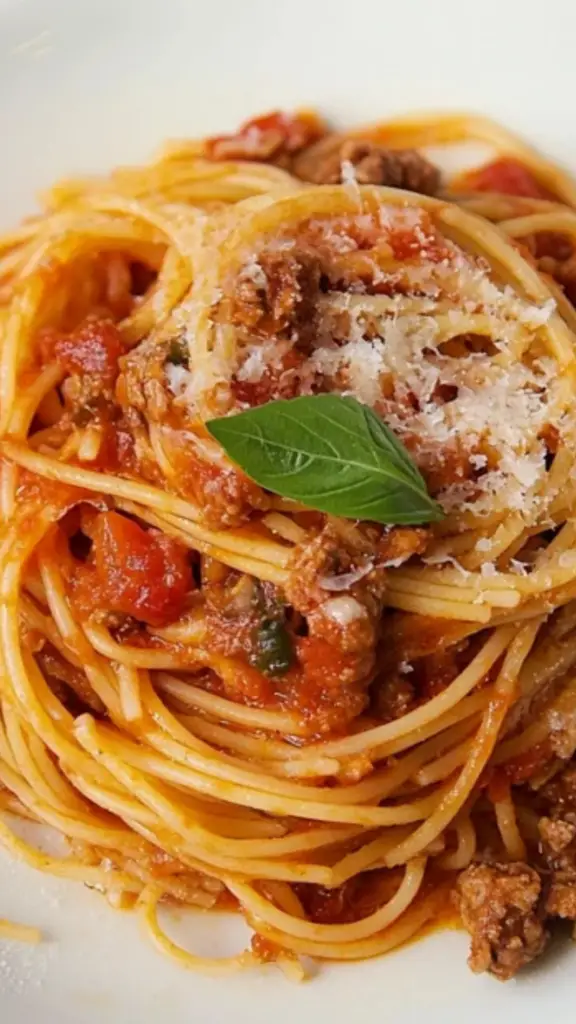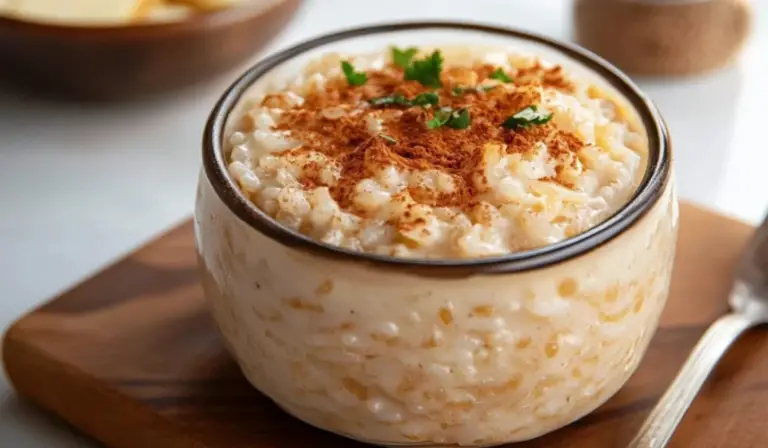Cuban Spaghetti: A Flavorful Twist on an Italian Classic
Spaghetti is one of the most beloved comfort foods worldwide, a dish that combines simplicity with heartiness. While Italian-style spaghetti is known for its rich tomato-based sauce and aromatic herbs, Cuban spaghetti brings a bold and savory twist. This version incorporates a well-seasoned ground beef sauce, a touch of spice, and a depth of flavor that makes every bite memorable.
PrintCuban Spaghetti: A Flavorful Twist on an Italian Classic
Cuban Spaghetti takes the comforting essence of traditional spaghetti and infuses it with rich, smoky spices, savory ground beef, and a zesty tomato sauce with a Cuban twist. This beginner-friendly recipe is packed with bold flavors in every bite! 🍝🔥🍅
- Prep Time: 10 minutes
- Cook Time: 30 minutes
- Total Time: 40 minutes
- Yield: 4 servings 1x
Ingredients
- ½ lb Spaghetti – Traditional spaghetti works best, but other pasta shapes like linguine or fettuccine can be used.
- 1 lb Ground Beef – Lean ground beef is ideal, but you can substitute it with ground chicken for a lighter option.
- 1 28 oz can Crushed Tomatoes – Provides a rich tomato base for the sauce. If unavailable, use whole canned tomatoes and crush them manually.
- ½ small Onion, finely chopped – Enhances the sauce’s depth and sweetness.
- ½ Green Bell Pepper, finely chopped – Adds a fresh and slightly bitter contrast to the sauce.
- 2 Garlic Cloves, minced – Essential for aromatic depth. Fresh garlic is recommended over pre-minced options for the best flavor.
Seasoning and Flavoring Agents
- 1 tsp Oregano – Adds warmth and an earthy touch to the sauce.
- ¼ tsp Cumin – Provides a subtle smoky flavor.
- 2 tsp Sazon – A key seasoning in Latin cuisine that enhances color and taste. If unavailable, use a mix of paprika, garlic powder, and ground coriander.
- 1 tbsp Tomato Paste – Thickens the sauce and intensifies the tomato flavor.
- 1 Bay Leaf – Infuses the sauce with a subtle herbal note. Remove before serving.
- ¼ cup Dry White Wine – Adds depth and acidity. If avoiding alcohol, substitute with chicken or beef broth.
- 3 tbsp Capers or Olives, chopped – Contribute a briny contrast that balances the dish’s richness.
- ¼ cup Parmesan Cheese – Brings a salty, nutty finish. Can be replaced with a dairy-free alternative if needed.
- Salt and Pepper to taste – Essential for balancing flavors.
Instructions
1. Cook the Ground Beef
Start by heating a large skillet over medium-high heat. Add the ground beef and cook until completely browned, breaking it apart with a wooden spoon. If using ground chicken, cook it until no pink remains. This step ensures that the meat is fully cooked before adding other ingredients.
2. Sauté the Aromatics and Spices
Once the beef is browned, add the chopped onion, bell pepper, and minced garlic. Cook for about three minutes, stirring occasionally. The vegetables should soften slightly, releasing their flavors into the meat.
Add the tomato paste, bay leaf, Sazon, cumin, oregano, salt, and pepper. Stir well to coat the meat evenly with the seasonings. Cooking the spices for a minute or two allows their flavors to bloom, creating a more aromatic sauce.
3. Deglaze with White Wine
Pour in the dry white wine, stirring to loosen any browned bits stuck to the pan. Allow it to reduce by half, which takes about two to three minutes. This step deepens the flavor and balances the acidity in the sauce. If using broth instead of wine, let it reduce in the same manner.
4. Simmer the Sauce
Add the crushed tomatoes and a small pinch of sugar (optional) to balance the acidity. Reduce the heat to low and let the sauce simmer for 30 minutes, stirring occasionally. This slow cooking process allows the flavors to meld and develop a richer taste.
5. Boil the Spaghetti
While the sauce simmers, bring a large pot of salted water to a boil. Add the spaghetti and cook according to the package instructions until al dente. Drain the pasta, but reserve about ½ cup of pasta water in case the sauce needs adjusting later.
6. Final Touches and Serving
Remove the bay leaf from the sauce. Stir in the capers or chopped olives, then add the drained spaghetti. Toss everything together, ensuring the pasta is well-coated with the sauce. If the sauce seems too thick, add a splash of the reserved pasta water to loosen it.
Sprinkle with Parmesan cheese before serving for an added savory touch.
Notes
- How to tell if the pasta is done: The best way to check if spaghetti is cooked is to taste it. It should be firm but tender (al dente). Overcooked pasta becomes mushy and does not hold the sauce well.
- Preventing overcooked vegetables: Since the onions and peppers continue cooking in the sauce, sauté them only until slightly softened. This prevents them from turning mushy.
- What to do if the sauce is too acidic: A small pinch of sugar or a drizzle of honey can help balance the acidity of canned tomatoes without making the sauce sweet.
- Enhancing the flavor: Letting the sauce simmer longer (up to an hour) will intensify its taste. If short on time, ensure at least 30 minutes of simmering for good flavor.
- Storing leftovers: Store any leftovers in an airtight container in the refrigerator for up to three days. Reheat gently on the stove or in the microwave with a splash of water to prevent drying out.
The beauty of Cuban spaghetti lies in its straightforward preparation. This recipe is perfect for beginner cooks because it uses easy-to-find ingredients, simple cooking techniques, and requires minimal prep work. With just a few steps, anyone can create a flavorful and satisfying dish that tastes like it has been simmering all day.
For those looking to explore Cuban flavors while keeping the cooking process accessible, this dish is an excellent starting point. It combines savory beef, vibrant spices, and a slightly sweet tomato base, making it a unique yet approachable meal.
Why This Recipe is Perfect for Beginners
- Easy to follow: Each step is simple, and the ingredients are easy to work with.
- Time-efficient: The whole dish comes together in about 40 minutes, making it great for weeknight dinners.
- Rich and flavorful: The seasoning blend and cooking method develop deep flavors with minimal effort.
- Customizable: The recipe can be adjusted with different proteins, vegetables, and seasoning levels to suit personal preferences.
Ingredients and Substitutions
To make this Cuban-inspired spaghetti, you will need the following ingredients.
Main Ingredients
- ½ lb Spaghetti – Traditional spaghetti works best, but other pasta shapes like linguine or fettuccine can be used.
- 1 lb Ground Beef – Lean ground beef is ideal, but you can substitute it with ground chicken for a lighter option.
- 1 28 oz can Crushed Tomatoes – Provides a rich tomato base for the sauce. If unavailable, use whole canned tomatoes and crush them manually.
- ½ small Onion, finely chopped – Enhances the sauce’s depth and sweetness.
- ½ Green Bell Pepper, finely chopped – Adds a fresh and slightly bitter contrast to the sauce.
- 2 Garlic Cloves, minced – Essential for aromatic depth. Fresh garlic is recommended over pre-minced options for the best flavor.
Seasoning and Flavoring Agents
- 1 tsp Oregano – Adds warmth and an earthy touch to the sauce.
- ¼ tsp Cumin – Provides a subtle smoky flavor.
- 2 tsp Sazon – A key seasoning in Latin cuisine that enhances color and taste. If unavailable, use a mix of paprika, garlic powder, and ground coriander.
- 1 tbsp Tomato Paste – Thickens the sauce and intensifies the tomato flavor.
- 1 Bay Leaf – Infuses the sauce with a subtle herbal note. Remove before serving.
- ¼ cup Dry White Wine – Adds depth and acidity. If avoiding alcohol, substitute with chicken or beef broth.
- 3 tbsp Capers or Olives, chopped – Contribute a briny contrast that balances the dish’s richness.
- ¼ cup Parmesan Cheese – Brings a salty, nutty finish. Can be replaced with a dairy-free alternative if needed.
- Salt and Pepper to taste – Essential for balancing flavors.
Step-by-Step Instructions
1. Cook the Ground Beef
Start by heating a large skillet over medium-high heat. Add the ground beef and cook until completely browned, breaking it apart with a wooden spoon. If using ground chicken, cook it until no pink remains. This step ensures that the meat is fully cooked before adding other ingredients.
2. Sauté the Aromatics and Spices
Once the beef is browned, add the chopped onion, bell pepper, and minced garlic. Cook for about three minutes, stirring occasionally. The vegetables should soften slightly, releasing their flavors into the meat.
Add the tomato paste, bay leaf, Sazon, cumin, oregano, salt, and pepper. Stir well to coat the meat evenly with the seasonings. Cooking the spices for a minute or two allows their flavors to bloom, creating a more aromatic sauce.
3. Deglaze with White Wine
Pour in the dry white wine, stirring to loosen any browned bits stuck to the pan. Allow it to reduce by half, which takes about two to three minutes. This step deepens the flavor and balances the acidity in the sauce. If using broth instead of wine, let it reduce in the same manner.
4. Simmer the Sauce
Add the crushed tomatoes and a small pinch of sugar (optional) to balance the acidity. Reduce the heat to low and let the sauce simmer for 30 minutes, stirring occasionally. This slow cooking process allows the flavors to meld and develop a richer taste.
5. Boil the Spaghetti
While the sauce simmers, bring a large pot of salted water to a boil. Add the spaghetti and cook according to the package instructions until al dente. Drain the pasta, but reserve about ½ cup of pasta water in case the sauce needs adjusting later.
6. Final Touches and Serving
Remove the bay leaf from the sauce. Stir in the capers or chopped olives, then add the drained spaghetti. Toss everything together, ensuring the pasta is well-coated with the sauce. If the sauce seems too thick, add a splash of the reserved pasta water to loosen it.
Sprinkle with Parmesan cheese before serving for an added savory touch.
Beginner Tips and Notes
- How to tell if the pasta is done: The best way to check if spaghetti is cooked is to taste it. It should be firm but tender (al dente). Overcooked pasta becomes mushy and does not hold the sauce well.
- Preventing overcooked vegetables: Since the onions and peppers continue cooking in the sauce, sauté them only until slightly softened. This prevents them from turning mushy.
- What to do if the sauce is too acidic: A small pinch of sugar or a drizzle of honey can help balance the acidity of canned tomatoes without making the sauce sweet.
- Enhancing the flavor: Letting the sauce simmer longer (up to an hour) will intensify its taste. If short on time, ensure at least 30 minutes of simmering for good flavor.
- Storing leftovers: Store any leftovers in an airtight container in the refrigerator for up to three days. Reheat gently on the stove or in the microwave with a splash of water to prevent drying out.

Serving Suggestions
Cuban spaghetti is a flavorful dish that pairs well with simple sides and accompaniments.
- Garlic Bread: Toasted bread with garlic butter complements the rich sauce.
- Side Salad: A fresh green salad with a citrus vinaigrette balances the dish’s heartiness.
- Steamed Vegetables: Lightly steamed broccoli or zucchini add color and nutrition.
- Fried Plantains: A sweet contrast to the savory pasta, fried plantains make a classic Cuban side.
For drinks, a glass of sparkling water with lime or a light iced tea pairs well with this dish, refreshing the palate between bites.
Final Thoughts
This Cuban spaghetti recipe is a perfect introduction to Latin flavors while remaining approachable for beginner cooks. It brings a unique twist to a familiar dish, making it a great way to expand your cooking skills without overwhelming complexity. The balance of savory beef, aromatic spices, and a lightly sweet tomato sauce makes it a crowd-pleaser.
Cooking should be enjoyable, and this recipe ensures success with minimal effort and maximum flavor. Try it out and feel free to experiment with different variations based on your preferences. If you make this dish, share your experience and any personal twists you added. Happy cooking!








